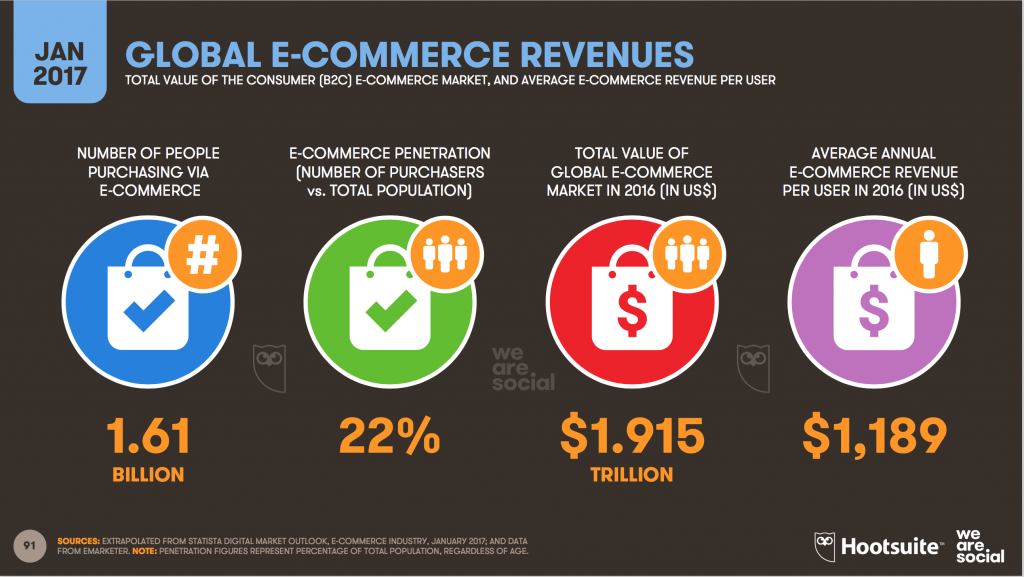The UAE is one of the most socially-engaged countries in the world, with the highest social media penetration globally, per Hootsuite’s “Digital in 2017” report.
But how does online shopping itself fare? Does Social Media penetration translate to actual online shopping?
Despite how easy it is to launch a web-store, scaling an online business in the Gulf remains extremely difficult even for the most seasoned e-commerce experts. Add to this the complex demographics of the Gulf population that is a mixture of locals & expatriates and we see that it’s not really a rosy picture as painted by the research studies. Which part of the world sees a major drop in retail and online sales because it’s summer time and most residents take the flight out to their home countries?!
Global Digital Snapshot
The Global Digital snapshot shows that there is a 50% penetration of Internet users within the world population and 37% of the world population is on some form of Social Media.

It also shows that 66% of the world population is using mobile devices.
Digital in the Middle East
The Middle East region has a slightly higher Internet penetration compared to the world average.

But it has an astoundingly high mobile penetration of 127% and compared to that a surprisingly lower social media penetration of 38%.
Global E-commerce Revenues
Globally in the year 2016, an average annual purchase of US$1,189 an be attributed to every user who has spent online.

E-commerce Penetration
The below chart shows UAE has a 62% penetration of E-commerce. That is an encouraging number, and a massive increase from just a few years ago.

But how much of that E-commerce is for an actual product and how much is for essentials such as paying bills online or buying flight tickets online?
Social Media Penetration
This is perhaps the best news related to the Internet in the UAE. 99% of the UAE population has at least one Social Media account, most likely Facebook. This is in spite of the fact that a small chunk of the resident UAE population is the labour class.

But once you are an expatriate, Facebook is a emotional way to connect to your homeland. And that explanation even covers the labour class. For the rest of us, we have more than one Social Media account anyway.
Digital Reality of the Middle East
Statistics and data aside, let us now look at the stark reality of digital world in the Middle East.
Shopping Malls still draw the crowds
The rise of shopping malls and outdoor retail destinations still draws in consumers to visit the brick-and-mortar shopping centres to make retail purchases – across fashion apparel, jewellery and electronics, even though globally many traditional consumer businesses are moving away from models that are geographically focused to ones that are customer-centric and borderless.
In January, a KPMG report said that UAE consumers shop less frequently online than the global average, suggesting further room for growth and adoption in the online space. However, even though UAE shoppers browsed online for less time, they were quick to spend: their average ticket size of US$332 was the highest in the world.
In the UAE, online shopping may never replace shopping malls since malls are an intrinsic part of life in the region, especially in the UAE. Malls have evolved into entertainment destinations where people spend time with family while they shop, dine and use entertainment facilities, and they are not likely to be replaced so easily. Furthermore, retail events such as the Dubai Shopping Festival – which provide incentives for visiting retail outlets and making physical purchases – continue to drive the popularity of this format.
Slow advent of Digital Marketing
The Middle East still remains a land of Full Page Newspaper advertisements, flashy roadside hoardings, mall brandings and retail POS (point of sale) investments. If a fraction of this massive investment is diverted towards online marketing, the Return on Investment will show a strikingly positive figure. But most organizations are waiting for who will take that first call. Furthermore, organizations that do not have a e-commerce destination do not feel it is worth that investment.
Low investment in Search Engine Optimization & Marketing
With the accessibility of the internet, most people turn to search engines for anything and everything. A well-optimized website can reach new audiences across the globe. Search Engine Optimization & Marketing needs to be looked at as a long-term investment instead of a cost. Almost any business can hire a specialist to help grow their business by shifting around unnecessary expenses or cutting advertising mediums that aren’t producing. With a strong SEO strategy, even small business can compete with even the biggest business organizations. The key is the business owners in Middle East need to understand that SEO is a marathon and not a sprint.
Arabic as an Internet language of commerce
Although Arabic has had the problem of being difficult to render on websites, translation of online content is crucial to giving businesses in the Middle East an advantage.
Only big names rule e-commerce
There are only a handful of pure-play e-tailers that rule the world of e-commerce in the middle east. This is because of the lack of conviction that many retailers have to take that leap of faith and go online.




Leave a Reply